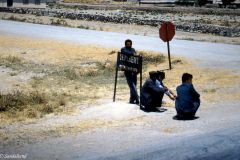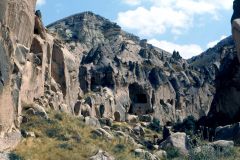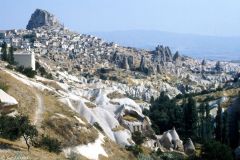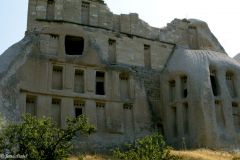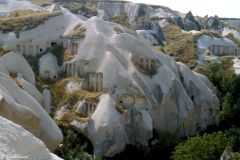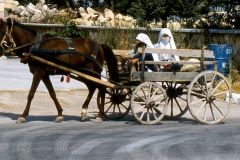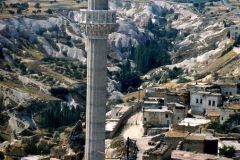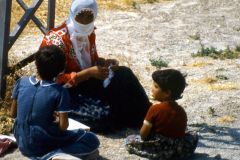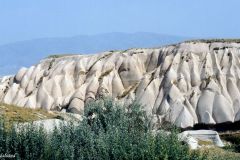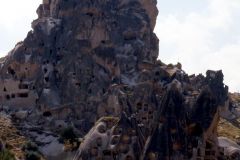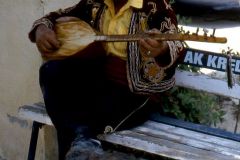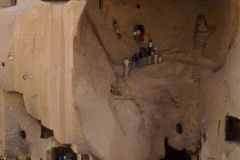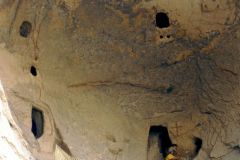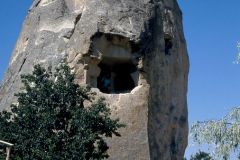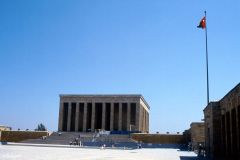The fascinating life and scenery on the Anatolian Plateau, as well as the bureaucratic hassles of continuing the journey.
This article is no. 2 of 5 in a series based on my travel diaries from 1986. I was on a five week journey to Turkey, Syria, Jordan and Israel / Palestina.
Tuesday 29.7.1986, Konya & Nevsehir
A long day. I got up early and went sightseeing in Konya. Dropped by a couple of museums and mosques, and wandered through the quite pleasant bazaar.
After this I went to the bus station. My aim was to go to Nevsehir and continue to the Göreme valley. That area in the Cappadocia region is famous for its strange rock formations. The soft rock has eroded into remarkable formations which the early Christians during persecutions further elaborated on. Churches, buildings, yes entire subterranean cities were dug out by St. Paul and his successors.
Well. I came too late for the morning buses and the next bus was not scheduled for another five hours. Instead I took a bus to Aksaray, along the same route (2 hours) and minibus the last stretch toNevsehir (1 hour, 600 TL). On the first leg I got acquainted with a Spaniard from the Basque region. We took the minibus together to Nevsehir but found each our hotels.
My intention was to move on, but I found out (with the aid of an eager tour-seller) that I could joint his group tour tomorrow. It cost me 7500 TL for a round trip of the region, including food and entry fees. Stiff price but the best way of doing it, I felt. So I found myself a hotel for the night and had dinner and a long conversation with the Spaniard.
- HOTEL KAYMAK. New hotel, 1 month old. Nice and clean. Single room 2200 + 300 for hot shower which I did not take. Right by the bus station
Wednesday 30.7.1986, Nevsehir & Göreme
Off on a day trip to a natural wonder. (Göreme is enlisted as a World Heritage Site). To bring the conclusion first: Excellent.
We started around nine and returned “home” at about seven in the evening. In the meantime we had a delicious three-course lunch, but above all a very rich, interesting and exciting round-trip in this strange area.
It is remarkable how water and wind, and humans, have managed to shape the landscape. Some places reminded me of the Grand Canyon in the USA, others of the Stone Forest in southern China, but most must be quite unique on a global perspective. There were churches everywhere. Some monasteries were located inside the cliffs. People had been digging large rooms, long dark tunnels and painted beautiful murals. In multitude. The sites date back to 600-800 AD.
Our guide was excellent, very knowledgeable and pleasant. Me and my company of seven Dutch people had a great trip.
In the evening I bought a bus ticket to Adana (1800 TL). So tomorrow it’s off towards the Middle East.
Thursday 31.7.1986 – Nevsehir, Adana & Antakya
Nothing much happened today. The bus to Adana took a bit more than 5 hours, passing by (at times) interesting landscapes.
There is not much to see in this town so I bought a bus ticket on to Antakya and left immediately. The ticked cost med 1000 TL and the trip lasted around 3 hours. My plan is to continue across the border toSyria tomorrow. I therefore tried to find the tourist information office but it was closed. In the end I found a hotel right next to the bus station.
- SEKER PALAS OTELI. Nothing to boast of. They even were out of single rooms but I was too tired and sweat to continue the search. The room cost me 2200 TL. Map
Friday 1.8.1986 – Antakya & Ankara
A terrible day. At the bus company that operates on Aleppo in Syria I learned that it was no longer possible to obtain visa on the border, and had not been so for the last three years. Even more, there was no Syrian consulate nearby which could issue me a visa. I therefore had to go to Ankara or Istanbul to fix this. I went to the tourist information office and it confirmed the fact.
My disappointment was huge. I had not imagined I would have to face such difficulties continuing my journey. But I had to go through Syria. I already had a visa to Jordan, and more important: A flight ticket from Tel Aviv to Stavanger (home) is already bought and must be used. The extra cost of going to Ankara is not the worst. It is rather bad the extra time I will be wasting because of this. And furthermore it is a fairly long way up north to Ankara – I’m starting to get pretty tired of all these long bus rides. But the necessity forced me to buy a ticket to Ankara with a departure at 1300. The price was 4000 TL.
Before we left I visited the very interesting Museum of Archaeology in Antakya. All the large mosaic works from the Roman era were very striking.
The trip to Ankara took 12 boring hours. I continued on to the Ulus area and found a dirty, scruffy little hotel I can’t remember the name of.
Saturday 2.8.1986 – Ankara
I have got loose stools. My stomach has not really been itself at any point during my stay here in Turkey, but now it has become really bad. In any case I got out of my awful little hotel, where I indeed only paid 1150 TL, and found after much walking and messing around a better place to stay.
- HOTEL EMRE PALAS. Çankiri Caddesi #17 in the Ulus area as well. That is an area with many cheap hotels according to my guidebook (LP). Pretty good, with sink in the room and hot shower in the corridor. The price was a bit stiff, 2500 TL, but I raise the budget a bit for the sake of my belly. Map
I took a bus to the Syrian embassy in the Çankaya-area. It is of course closed during the weekends. My o’ my, there went my last hope. I went straight back to my hotel and lay down on the bed. I dozed and slept all day. I’m thinking it is sufficient with one day sightseeing in the capital of Turkey.
In the evening I walked around a bit in the amusement park nearby, but returned early.
Sunday 3.8.1986 – Ankara
My fourteenth day in Turkey. My stomach has fortunately calmed itself. Long bus rides and too little to eat on Friday was probably the reason of the problem.
My sightseeing in the Turkish capital was a half day affair. Most interesting was the Museum of Archaeology and the Atatürk Mausoleum. The latter was a huge lump of stone or more precisely lumps of stone. It was impressive, but quite ridiculous in my opinion. This mini-god of a man is worshipped all over the country. Statues and pictures of him are found everywhere you go.
Monday 4.8.1986 – Ankara
Another exciting, and yes nerve wrecking day. Now I should finally get to know if I had to wait long to get a visa, or if I was at all able to obtain one. The address: Suriye Büyükelçilisi, Abdullah Cevdet Sok. 7, Çankaya. Take any bus going to Çankaya. The embassy was open to applicants between 9 and 10, perhaps a bit longer. Answer is given the same day between 13 and 14. The price for me was 5600 TL. One passport photo is necessary.
There was a long line when I got there, but it went fairly quick to submit my application. I was fortunately granted a 15 days tourist visa from what I understand. It is all in Arabic.
After this I went to the bus station and bought a ticket to Antakya tonight at 2030. That should make me arrive tomorrow in good time for the Aleppo buses at 13 and 14.
.
Thus I fared well. But the people who run the whole thing in the embassy can be pretty difficult. A Swiss couple were told to go home and get a visa there. A group of four Italian women and teenagers who were not so fluent in a foreign language were not even allowed to submit their application as far as I could tell. A Turk I talked to, practically had it as a job coming here with visa applications for foreigners. He worked in a transport company. In his opinion it seemed like the Italians where going to Israel. Doing that rules out any chance of going to Syria. Besides, it seemed to me that a Jordanian visa ought to be obtained in advance. I’m glad I got mine in Oslo.
This Turk also expressed the opinion that Syria did not want tourists. They often do not issue any tourist visas, only a 72-hours transit visa. I was in other words lucky. The two Swiss intended to go to Iran. They had waited 6 weeks for a transit visa. The Turk ruled out their chances. He had problems with a visa to a Swiss lorry driver with cargo to Iranian hospitals!
I also dropped by the Norwegian embassy and read a newspaper from Saturday. Çankaya is the embassy district and there are scores of soldiers with AGs and smaller side arms everywhere. In a garden there was even made a ditch with sand bags around a tree.
Some impressions from Turkey
Asia Minor, the land between East and West is much more interesting and worth seeing than I imagined before coming here. Before I had never been much occupied with Turkey and had therefore not read so much of the country, the people and their culture.
After fourteen days I am starting to form a more supplementary image of the country. The impression is positive. Turkey is easy to travel in. Buses go everywhere, tickets are cheap and sights are everywhere so that too long journey stages can be avoided.
Nature in the country is varied. From the great beaches along the Aegean and Mediterranean coastlines to the vast, partly naked and dry steppes in the very heart of Turkey – Anatolia. In the east lie more “uncivilised” areas with the mountain Ararat in the northeast corner. Even though I have not seen it all, this bear witness of opportunities few other countries can offer tourists.
.
And there are some tourists here as well, mostly Germans it seems. That it quite understandable as the Germans have had the Turkish closer than any other European country. There are actually around a million and half Turkish guest workers in West German today, and with a natural turnover over the years it is not strange that so many Turks speak German. As a matter of fact the understanding of German is better here than English. I therefore have had to dig out my old school German, quite successfully really.
Furthermore, it is not difficult to find ones way in Turkey. There is always someone who speaks German or English. And: There are lots of hotels in the cheaper categories, 3-5 dollars or less. Pretty nice as well, fortunately. There are tourist bureaus in most places of significance.
Turkey has over the centuries and millenniums been subject to numerous conquests and has indeed been active doing the same. This has left its marks in many ways. The museums I visited have been overly interesting and the buildings from ancient times have been well kept, like in Efes.
.
But most of all the Muslims have left their mark. Turkey is today a Muslim country – mosques are everywhere. But like in most countries the Western, secularised culture and way of thinking has had more and more to say. That is especially true in the cities, like Istanbul and Ankara of course.
If one should try and describe Turkey of today, one would despite this have to take a starting point in the religion – Islam. The traditions tied to it permeate everything from clothing, to gender stereotypes to philosophy.
The big man in modern Turkey is Mustafa Kemal. He “liberated” Turkey from the influence of Western powers and from the Ottoman Empire after World War I. His goal was to renew the country after so many years of mismanagement under the Ottomans. The country was after all called the “Sick Man of Europe” at the time. The modernisation process Kemal (called Atatürk “the father of the Turks”) initiated has since continued. A sign of this is the carpet sellers who complain about how difficult it is to get enough carpet weavers. School and other employs have taken over the preoccupation of the girls. (Boys can’t be used for tying knots – they are not patient enough, as a vendor told me.)
.
TV is the big thing, even with only one channel. Everywhere, even in the poorest home there is evidently a set. As well as in restaurants. But in the buses they prefer to play modernised Turkish folk music, called Arabesk.
I mentioned sexual stereotypes. Even though many, especially young, women dress up in modern clothes most are dressed in baggy dresses and coats with scarves on their heads. The hair should not be shown according to Muslim faith. In the countryside, at least in Anatolia, the woman wear baggy trousers called salvar. Men, in contrast, are dressed “normally”. And it is the men one sees in the numerous cafes, chain-smoking, and with a glass of tea in the hand. Their wives are presumably at home in the kitchen.
What surprised me, yes I was indeed shocked, was all the half naked ladies depicted in colourful Turkish newspapers. Actually several bodies on every page. And this is a Muslim country where several react on seeing a male tourist in shorts! Paradox it is called.
Another matter of the same kind is the brothels. In Bursa Emre showed me a place – yes a secluded area with gate and police guard outside who demanded identification of everyone. It contained several houses around a courtyard. Inside the houses the girls were sitting on exhibit. They were old, ugly and fat in my opinion. Outside the houses dozens of men were glaring in to see the “bad” women. I was told that these hookers were bad, but when I asked if the men visiting them were any better I did not get an answer…
.
The impression we have at home of the Turkish is that they are some scary, dangerous, knife-stabbing criminals. Well, some may be. I think however that the ones I have met were very helpful, nice and cheerful people who wouldn’t even “harm a cat” as we say it in Norway. And those who let such prejudices hinder a visit to Turkey, should change their attitude right away.
Money spent:
2 carpets: 150 USD
Everything else: 250 USD
Minus 25000 TL: 40 USD
Total: 360 USD.
Read more
This article is part of a series based on my travel diaries from 1986. I was on a five week journey to Turkey, Syria, Jordan and Israel / Palestina.
The big road map
This road trip started by flying into Istanbul and ended in Tel Aviv. All other transportation was by public buses.
All chapters
(1) Istanbul and the west coast of Turkey: This was a journey into the unknown and intriguing cultures of the Middle East, and the encounter of a friendliness and hospitality hard to come by anywhere. Turkey was first off.
(2) Roaming Turkey’s Anatolian plateau: The fascinating life and scenery on the Anatolian Plateau, as well as the bureaucratic hassles of continuing the journey.
NEXT CHAPTER: (3) Deserts, towns and memorials of Syria: Syria was a closed country, not welcoming tourists. But what an exciting past and present! In combination with an eagerness among young people to meet Westerners the stage was set for an exciting week.
(4) Jordan’s capital, Petra and the Dead Sea: Few places on planet Earth are as legendary as Petra, and few activities as fascinating as swimming in the Dead Sea. This chapter of my journey also tells the tale of my unpleasant encounter with a Palestinian soldier.
(5) A dive into ancient history in Israel and Palestine: This is the last part of my five week journey. Israel – finally I had come to the Promised Land.


